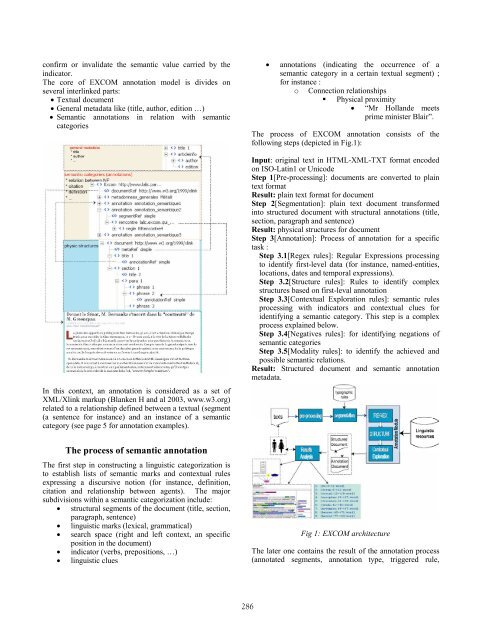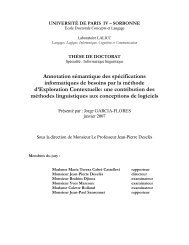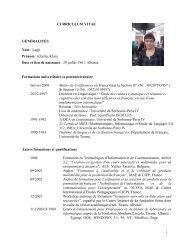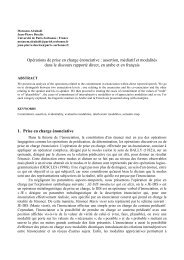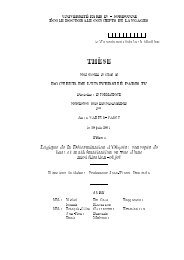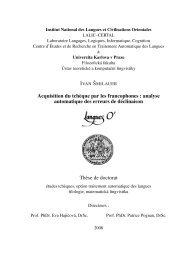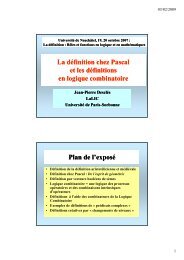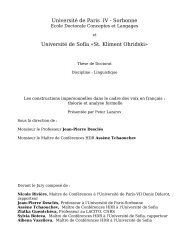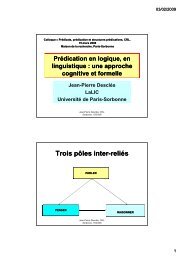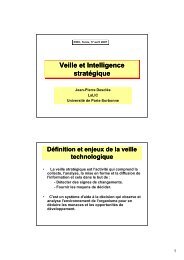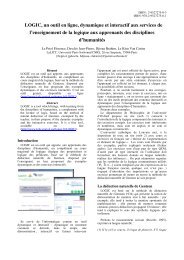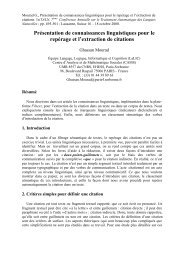EXCOM: An Automatic Annotation Engine for ... - ResearchGate
EXCOM: An Automatic Annotation Engine for ... - ResearchGate
EXCOM: An Automatic Annotation Engine for ... - ResearchGate
You also want an ePaper? Increase the reach of your titles
YUMPU automatically turns print PDFs into web optimized ePapers that Google loves.
confirm or invalidate the semantic value carried by the<br />
indicator.<br />
The core of <strong>EXCOM</strong> annotation model is divides on<br />
several interlinked parts:<br />
• Textual document<br />
• General metadata like (title, author, edition …)<br />
• Semantic annotations in relation with semantic<br />
categories<br />
In this context, an annotation is considered as a set of<br />
XML/Xlink markup (Blanken H and al 2003, www.w3.org)<br />
related to a relationship defined between a textual (segment<br />
(a sentence <strong>for</strong> instance) and an instance of a semantic<br />
category (see page 5 <strong>for</strong> annotation examples).<br />
• annotations (indicating the occurrence of a<br />
semantic category in a certain textual segment) ;<br />
<strong>for</strong> instance :<br />
o<br />
Connection relationships<br />
<br />
Physical proximity<br />
• “Mr Hollande meets<br />
prime minister Blair”.<br />
The process of <strong>EXCOM</strong> annotation consists of the<br />
following steps (depicted in Fig.1):<br />
Input: original text in HTML-XML-TXT <strong>for</strong>mat encoded<br />
on ISO-Latin1 or Unicode<br />
Step 1[Pre-processing]: documents are converted to plain<br />
text <strong>for</strong>mat<br />
Result: plain text <strong>for</strong>mat <strong>for</strong> document<br />
Step 2[Segmentation]: plain text document trans<strong>for</strong>med<br />
into structured document with structural annotations (title,<br />
section, paragraph and sentence)<br />
Result: physical structures <strong>for</strong> document<br />
Step 3[<strong>An</strong>notation]: Process of annotation <strong>for</strong> a specific<br />
task :<br />
Step 3.1[Regex rules]: Regular Expressions processing<br />
to identify first-level data (<strong>for</strong> instance, named-entities,<br />
locations, dates and temporal expressions).<br />
Step 3.2[Structure rules]: Rules to identify complex<br />
structures based on first-leval annotation<br />
Step 3.3[Contextual Exploration rules]: semantic rules<br />
processing with indicators and contextual clues <strong>for</strong><br />
identifying a semantic category. This step is a complex<br />
process explained below.<br />
Step 3.4[Negatives rules]: <strong>for</strong> identifying negations of<br />
semantic categories<br />
Step 3.5[Modality rules]: to identify the achieved and<br />
possible semantic relations.<br />
Result: Structured document and semantic annotation<br />
metadata.<br />
The process of semantic annotation<br />
The first step in constructing a linguistic categorization is<br />
to establish lists of semantic marks and contextual rules<br />
expressing a discursive notion (<strong>for</strong> instance, definition,<br />
citation and relationship between agents). The major<br />
subdivisions within a semantic categorization include:<br />
• structural segments of the document (title, section,<br />
paragraph, sentence)<br />
• linguistic marks (lexical, grammatical)<br />
• search space (right and left context, an specific<br />
position in the document)<br />
• indicator (verbs, prepositions, …)<br />
• linguistic clues<br />
Fig 1: <strong>EXCOM</strong> architecture<br />
The later one contains the result of the annotation process<br />
(annotated segments, annotation type, triggered rule,<br />
286


